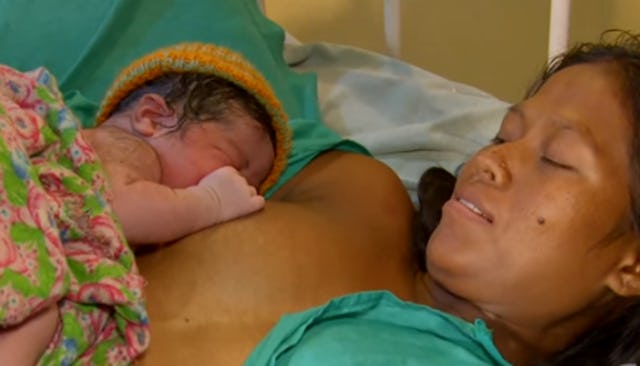Prepare To Be Amazed By These Babies Crawling To The Breast Right After Birth

Whether you breastfeed or not, you have to admit — it’s a pretty fascinating thing. The fact that women are able (barring any issues) to sustain an infant with their own bodies is one of nature’s coolest tricks. What you might not know is that infants are born instinctively knowing how to do it. It’s called the “breast crawl” and it’s nothing short of amazing. The World Health Media Project put out a video showing how it works and you won’t believe what brand-new babies are capable of doing.
We’re told over and over by doctors, the media, lactivists and our nosy aunt how “natural” breastfeeding is. And it is. But that doesn’t always mean it will come naturally to a new mom and her fussy infant. Maybe it’s because the way some moms are taught is forced and unnatural. The breast crawl is meant to be as natural as possible, allowing an infant to spend the first hour of life instinctively finding their way to the mother’s nipple to nurse for the first time. This video shows the way it should be and when you hear the “why” behind it, it makes perfect sense:
The video is long, but the gist of it is this: within the first hour of birth, a baby should remain on the mother’s torso. This helps regulate their body temperature and facilitate a natural entry into the world and out of the warm and cozy womb they’ve grown accustomed to.
The narrator of the video describes drying the baby off while it lays on it’s mother but leaving the hands coated in amniotic fluid. The scent of the fluid is similar to the scent of the mother’s nipple and aids the baby in locating it. In the video, the babies successfully find the nipple and latch on their own as they slowly warm up against their mother’s skin and make their own way in deciding when it’s time to feed. Isn’t that incredible? It’s like nature gives the baby all the tools and the mother barely has to lift a finger.
According to a study by the Karolinska Institute in Sweden, the breast crawl is successful nearly every time it’s attempted:
Immediately after birth the child was dried and laid on the mother’s chest. In the control group a regular behavioural sequence, previously not described in the literature, was observed. After 15 minutes of comparative inactivity, spontaneous sucking and rooting movements occurred, reaching maximal intensity at 45 minutes. The first hand-to-mouth movement was observed at a mean of 34 plus or minus 2 minutes after birth and at 55+ minutes the infant spontaneously found the nipple and started to suckle.
The study also states, “Babies completing the Breast Crawl with spontaneous attachment is instinctive and almost a rule with very few requiring assistance.”
In reality, most moms don’t have this experience. The first hour of a baby’s life, unless a mother requests otherwise, is typically spent being bathed, weighed, and given the APGAR. It’s not always that way, but it often is. It doesn’t take a rocket scientist to figure out that this is probably not an ideal start. It’s abrupt for a newborn to come out of the quiet womb and into a sterile hospital room with tons of noise. The breast crawl ensures a baby isn’t disrupted at first and is instead left to bond with the mother, which leads to easier nursing. It makes total sense, and science backs it up.
Learning to nurse my son felt forced. Right after I was wheeled out from my c-section and settled into recovery, I had the chance to nurse him. While I was glad for how quickly that happened since I thought it might take longer after a surgical birth, he really didn’t seem ready. I remember the nurse holding the back of his head and urging him toward my breast, which this video says explicitly not to do. He pushed his head backward, resisting. It seemed he only wanted to be near me and close to my skin. He was a frantic nurser in those first days and took ages to latch and looking back, I wonder if letting him come to feeding at his own speed may have helped? It felt as though the nurses wanted to check “make sure baby nurses” off their checklist even though it didn’t fit our time-table.
Every mom has an ideal post-birth scenario and of course, some moms don’t breastfeed at all. But for the ones that want nursing to work, this might be something to consider trying. Learning to nurse a baby can be very difficult and new moms can use every tip and advantage possible to make it an easy transition. Knowing a baby is literally born ready to figure it out can help us facilitate things at their own pace.
This article was originally published on